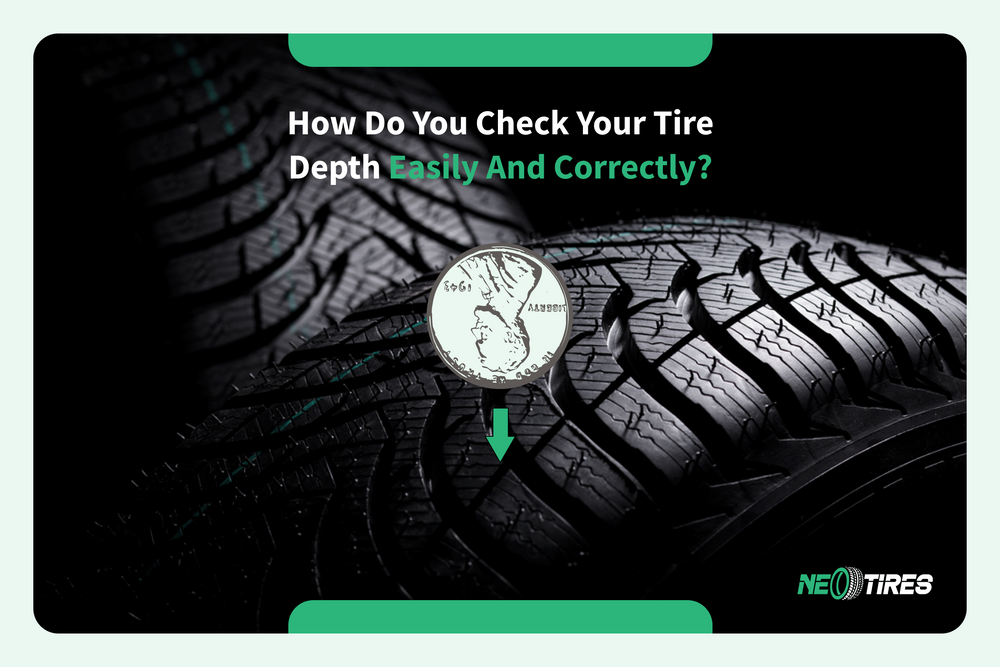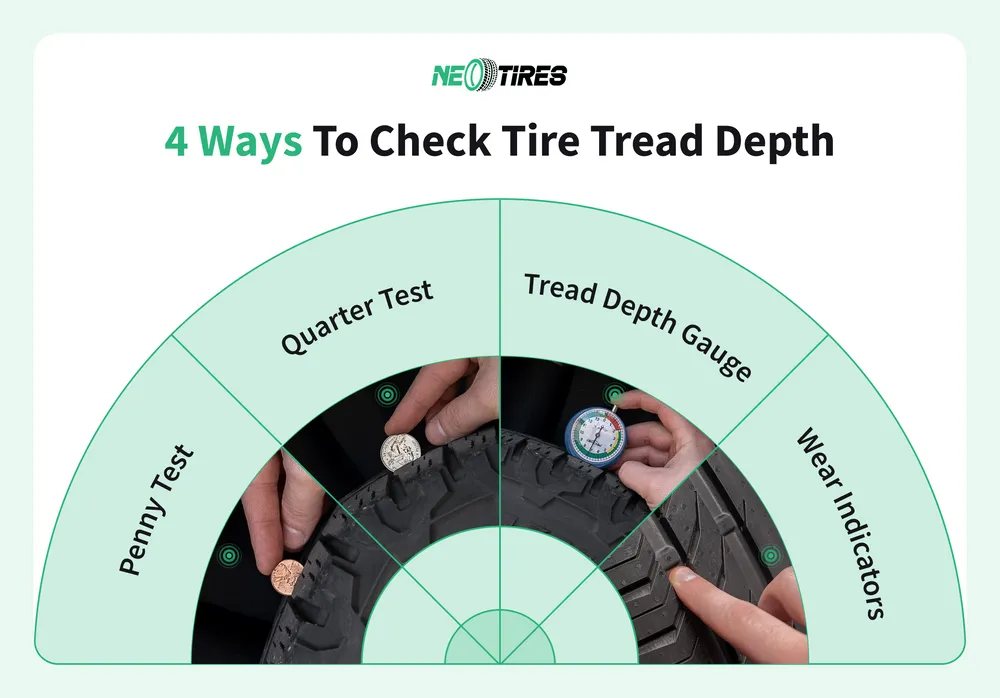Tire tread depth tells you how much usable rubber is left between your vehicle and the road. Checking it takes less than a minute by using the penny test, quarter test, a tread depth gauge, or the built-in wear bars to measure your tires and know immediately whether they're safe, borderline, or dangerously worn.
This step-by-step guide breaks down how to measure your tire tread depth correctly, using methods that any driver can apply. After, you'll be able to check our Tire Tread Depth Chart article to know what exactly your depth reading means and what actions you should take next.
Table Of Contents:
4 Ways To Check Tire Tread Depth
There are four ways you can use to check your tread depth:
Test Method | Measures | Best For | Limitation |
Penny Test | 2/32" (legal minimum) | Quick legal check | Only catches extreme wear |
Quarter Test | 4/32" (safety threshold) | Real-world rain safety | Less precise than a gauge |
Tread Depth Gauge | Exact measurement | Accurate monitoring | Generally affordable; certain models - expensive |
Wear Bars | 2/32" visual indicator | No tools needed | Only shows the legal limit |
1. Using the Penny Test (a common free test)
For checking the legal minimum threshold (2/32″).
2. Using the Quarter Test (better for rain safety)
More sensitive for detecting reduced wet-weather grip at 4/32″.
3. Using A Tread Depth Gauge
This inexpensive tool gives precise readings in both 32nds of an inch and millimeters.
4. Reading Tire Built-In Wear Bars
Most modern tires include tread wear indicators to indicate areas where the tread reaches the 2/32 legal limit, suggesting the need for tire replacement.
A tread depth gauge is the most accurate tool. Coins are quick and easy, ideal for a fast check. Wear bars are a visual last-resort indicator showing when the tire has reached the legal limit.
Step-by-Step Guide to Measure Tread Depth
Below are the four most reliable ways to check your tire depth: using a Penny, a Quarter, a Tread Depth Gauge, or by reading your tire wear indicators.
How to Perform the Penny Test
- Hold a penny with Lincoln’s head facing down.
- Insert it into the tread groove at the center of the tire.
- Look at Lincoln’s forehead.
What Your Reading Means
If all of Lincoln’s head is visible, your tread is at or below 2/32″- the legal minimum. Tires at this depth are unsafe and should be replaced immediately.
- If Lincoln’s forehead is partially covered:
You have more than 2/32″ → legal but may not be safe in wet conditions. - If the tread fully covers his head:
Your tires still have usable depth.
Why It Works
Lincoln’s head in the U.S. penny is exactly 2/32″ tall. If your tread doesn’t reach above it, your tires cannot maintain the required grip.
How To Perform The Quarter Test (Best for Rain Safety)
- Take a quarter with Washington’s head facing down.
- Insert it into the center tread groove.
- Observe the position of Washington’s head.
Drivers begin losing wet traction around 4/32″, not 2/32″, which is why the Quarter test is a more practical, real-world test because many safety issues appear long before the legal limit.
What Your Reading Means
If all of Washington’s head is visible, your tread is at or below 4/32″. While still above the legal minimum, traction is compromised in wet conditions, so replacement should be planned soon.
- Head partially covered?
Tread is above 4/32″ → meaning the tires are safe for daily driving, but you still need to continue monitoring.
Why It Works
The distance from the edge of the quarter to the top of Washington’s head is 4/32″, a known safety threshold for wet roads.
How to use a Tread Depth Gauge (Most Accurate)
- Insert the probe into a tread groove.
- Press the shoulders of the gauge flat against the tread block.
- Read the value in:
- 32nds of an inch
- millimeters
How to Interpret Gauge Readings
- 8/32″ to 11/32″ (6–9 mm): Excellent
- 6/32″ (4.5 mm): Good enough
- 4/32″ (3 mm): Replace soon (wet driving risk)
- 2/32″ (1.6 mm): Replace immediately (illegal in many areas)
Why Use a Gauge?
Using a tread depth gauge eliminates guesswork. You get a direct measurement, allowing you to compare it with the official Tire Tread Depth Chart.
How to Check Built-In Tread Wear Bars
- Look for the small bars running perpendicular across the grooves.
- If these bars are flush with the tread, your tire is at 2/32″.
- If the bar is still recessed below the tread, you still have usable depth.
Wear bars are small, raised rubber strips located inside the tread grooves. They indicate the legal minimum tread depth of 2/32″. When the tread reaches the same level as these bars, you need to replace the tire right away.
Why It Works
Manufacturers design these bars to match the legal minimum. When the tread reaches the height of the bars, the tire must be replaced.
Common Mistakes to Avoid (These Lead to Wrong Readings)
Be aware of the following mistakes when checking your tire tread depth to avoid incorrect readings: checking only one spot, measuring only one tire, ignoring uneven wear patterns, and checking depth while the tires are hot. Here is the breakdown:
Checking Only One Spot
Tires are likely to wear unevenly; center and shoulder wear can differ, depending on the factors causing the uneven wear (underinflation, overinflation, etc). The best practice is to check at least three spots across each tire.
Why Your Measurements Must Be Taken in Several Places
Tires can wear unevenly; checking only one point can give a false sense of safety. A tire’s inner, outer, and center sections wear differently depending on:
- alignment issues
- under/over-inflation
- driving style
- suspension wear
- vehicle weight distribution
For example, underinflation causes shoulder wear, while over-inflation causes center wear. Measuring tread depth at multiple points reveals hidden risks and helps diagnose mechanical issues.
Measuring Only One Tire
If one tire is worn, the others may be close behind. Or, one single tire can still develop wear, even if the rest of the tires look good. The best practice is to measure all four tires and check the spare if you use it regularly.
Ignoring Uneven Wear Patterns
Uneven wear can often suggest mechanical issues (misalignment, suspension issues, balance issues). The best practice is to get a professional inspection if you notice tire wear patterns developing, as a mechanic can detect and resolve the underlying problem.
Wear Pattern | Location | Likely Cause | Solution |
Center wear | Middle of the tread | Over-inflation | Reduce tire pressure |
Shoulder wear (both sides) | Outer edges | Under-inflation | Increase tire pressure |
One-side wear | Inner or outer edge only | Misalignment | Get wheel alignment |
Cupping/scalloping | Patchy wear around the tire | Suspension issues | Inspect shocks/struts |
Feathering | Tread ribs rounded on one side | Toe misalignment | Alignment check |
Checking When Tires Are Hot
While the temperature effect doesn't significantly alter the depth of the tread grooves, surrounding conditions can influence related measurements, such as pressure and the tire's overall condition. The best practice is to measure tread depth in the morning or after the car has sat for several hours.
What To Do After Measuring Your Tread Depth
Once you have a reading, the next steps are the following: keep your tires properly maintained (rotate, ensure pressure) if your tread is deep enough; start budgeting for replacement if your tires are at 4/32’’; replace tires soon if your tires are at 3/32 as your wet performance starts to be at risk; or replace tires now if your tires reach 2/32’’, which is the legal limit.
If Your Depth Is 6/32″ or Above
You’re in the safe zone. What you can do now is to keep:
- Rotating your tires every 6,000–8,000 miles.
- Maintaining proper inflation.
- Rechecking monthly.
If Your Depth Is 4/32″
This is the caution zone; still above the legal minimum of 2/32″, but traction is noticeably reduced in wet conditions. At 4/32″, your ability to evacuate water drops significantly, increasing stopping distances.
What you can do now is to:
- Start budgeting for replacement.
- Avoid aggressive driving in the rain.
- Monitor wear monthly or bi-monthly.
If Your Depth Is 3/32″ or Below
The tread is above the legal minimum (2/32″) but unsafe for wet, slushy, or snowy roads. Replace tires soon to maintain traction. Shallow tread means the water/slush/ wet snow can’t escape efficiently, making the tire float rather than grip. Hydroplaning risk spikes.
What you can do now is to:
- Replace tires soon.
If Your Depth Is 2/32″ or Below
This is the legal stop line. With such depth, your tires are legally worn out, providing minimal grip and skyrocketing your braking distance. The extra risk you take is that your insurance may deny claims.
What you can do now is to:
- Replace immediately.
Legal vs. Safe Tread Depth: What’s the Real Difference?
The legal minimum in most U.S. states is 2/32 inch. This is the limit for compliance. However, tires usually start to lose stable wet traction around 4/32 inch. It is recommended to replace tires at or above 4/32 inch for better safety on the road.
How Often You Should Check Your Tire Tread Depth
It’s highly recommended to check your tread depth once a month and before long trips.
Monthly tread depth checks catch minor issues (misalignment, suspension) before these issues compromise safety. Heat cycles, load changes, and seasonal driving conditions accelerate wear unpredictably. If your tires are older or unevenly worn, inspect them more frequently and consider replacing them soon.
Safe Tread Depth Means Safer Driving
Checking tire tread depth is simple, fast, and can be done with a gauge, coins, or visual wear indicators. Replace tires around 4/32" for best performance, and always measure in multiple places to catch uneven wear. Good tread isn’t just about compliance; it’s about maintaining control, braking predictably, and staying safe in unpredictable conditions.
How NeoTires Can Help You?
If your tread depth is getting close to the limit, we’re here to help you choose the right replacement with confidence. At NeoTires, we offer a wide range of options for every season, budget, and driving style - whether you need something for daily commuting, winter traction, off-road stability, farming, or long-distance comfort. Our team can guide you toward the best fit for your vehicle, and ship quickly across the U.S., so you’re not left waiting when safety matters most.
Contact Us for personal support.
Drive safe and check your tread depth wisely!







